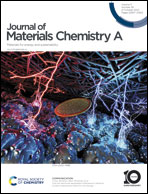High-performance Ruddlesden–Popper perovskite oxide with in situ exsolved nanoparticles for direct CO2 electrolysis†
Abstract
Carbon dioxide (CO2) is one of the principal greenhouse gases accountable for global warming and extreme climate changes. Electrochemically converting CO2 into carbon monoxide (CO) is a promising approach for CO2 utilization in achieving industrial decarbonization. High-temperature CO2 electrolysis via solid oxide electrolysis cells (SOECs) has great potential, including high-energy efficiency, fast electrode kinetics, and competitive cost; however, this technology still has challenges associated with developing highly active, robust CO2 electrodes for SOECs. We report novel Ruddlesden–Popper structured Pr1.2Sr0.8Mn0.4Fe0.6O4−δ (RP-PSMF) with in situ exsolved Fe nanoparticles as the CO2 electrode in SOECs for direct CO2 conversion to CO. The mechanism of CO2 electrolysis is studied by using the distribution of relaxation times method from electrochemical impedance spectroscopy. La0.8Sr0.2Ga0.8Mg0.2O3−δ (LSGM)-electrolyte supported SOECs with the RP-PSMF cathode have achieved exceptionally high current densities of 2.90, 1.61, 0.91, and 0.48 A·cm−2 at an applied voltage of 1.5 V at 800, 750, 700, and 650 °C, respectively. Moreover, SOECs with the RP-PSMF cathode have exhibited a stable electrolysis performance for 100 h under a current cycling operation. These results suggest that RP-PSMF with exsolved Fe nanoparticles is a highly promising cathode for high-temperature direct CO2 electrolysis cells.



 Please wait while we load your content...
Please wait while we load your content...